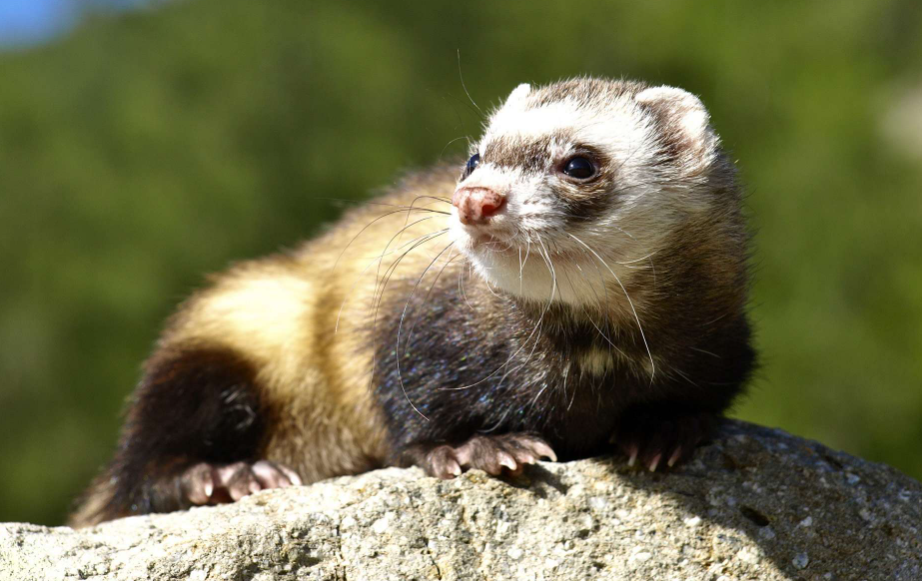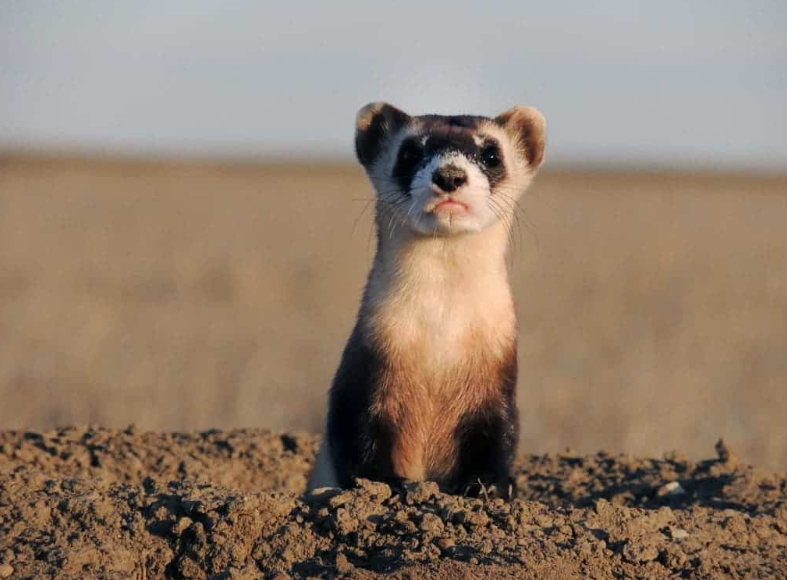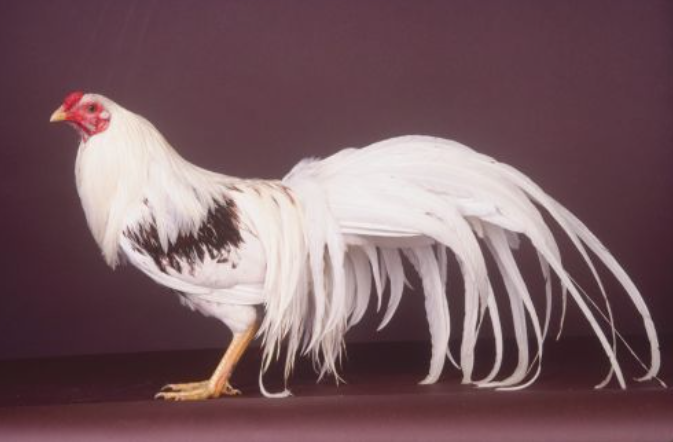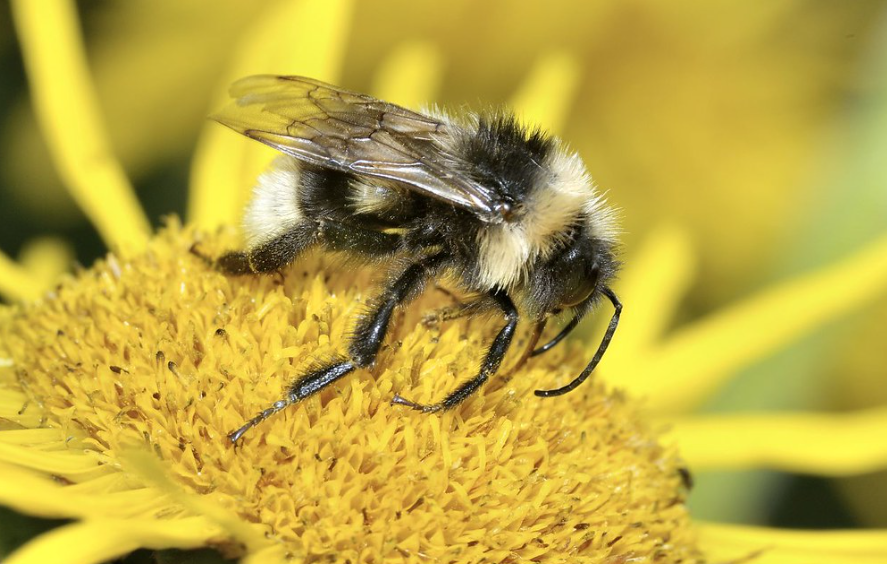
Quick Top 10 Facts about Black-Footed Ferret
| SCIENTIFIC NAME | Mustela nigripes |
| CLASSIFICATION | KINGDOM: Animalia PHYLUM: Chordata CLASS: Mammalia ORDER: Carnivora FAMILY: Mustelidae GENUS: Mustela |
| SIZE | About 18–24 inches (46–61 cm) long, with a tail length of about 5–8 inches (13–20 cm) |
| HABITAT | Grasslands, prairies, and open areas of North America |
| DIET | Primarily prairie dogs; also hunt other small mammals, birds, and insects |
| SPECIES | 1 species: Mustela nigripes (Black-footed Ferret) |
| COUNTRY | Native to North America, primarily in the western United States |
| GESTATION PERIOD | 42–43 days |
| LIFE SPAN | 6–14 years in the wild |
| CONSERVATION STATUS | Endangered – Once considered extinct in the wild, conservation efforts have led to a recovery |
Amazing Facts About Black-Footed Ferret
1. One of North America’s most endangered mammals
The Black-footed Ferret is one of the most endangered mammals in North America, with significant recovery efforts ongoing.
2. Highly specialized diet
They are strictly carnivorous and primarily feed on prairie dogs, which make up around 90% of their diet.
3. Expert hunters
Black-footed Ferrets are highly skilled hunters, using stealth and speed to catch prey.
4. Excellent burrowers
Ferrets often inhabit burrows dug by prairie dogs, and they have adapted to living in these underground environments.
5. Small but fierce
Though small in size, Black-footed Ferrets are aggressive hunters and will fight to defend their territory.
6. Remarkably vocal
Black-footed Ferrets use a variety of vocalizations, including growls, yelps, and hisses, to communicate with each other.
7. Conservation success story
Once thought to be extinct in the wild, the species has made a comeback due to conservation programs and captive breeding.
8. They are nocturnal
Black-footed Ferrets are primarily nocturnal hunters, active at night and resting in burrows during the day.
9. Life in colonies
These ferrets live in colonies, often relying on prairie dog colonies to provide them with food and shelter.
10. Active in the wild and in captivity
In the wild, Black-footed Ferrets roam over a wide area, but in captivity, they tend to be kept in much smaller spaces for breeding and care.
Distinctive features of the black-footed ferret as a species
The Black-Footed Ferret, or Mustela nigripes, as it is scientifically known, is a small carnivorous mammal native to North America. Its distinguishing characteristics include its slender build, black feet, and distinctive black mask covering its face. This species is well adapted to its grassland habitat because of its long, thin body, which allows it to burrow through its main food source, the prairie dog.
Reasons for Black-Footed Ferret decline include habitat loss and disease
The Black-Footed Ferret is an endangered species whose population has declined dramatically over time, rendering it vulnerable. The primary reason for this decrease is habitat loss brought on by the agricultural use of grasslands. Furthermore, the emergence of diseases like the sylvatic plague has had a negative impact on the ferret population. To protect and enhance their habitat and increase their number, efforts have been undertaken in both captive breeding and conservation.
Black-Footed Ferrets primary prey is prairie dogs
Prairie dogs make up around 90% of the diet that Black-Footed Ferrets devour. They are very proficient hunters who rely on their speed and dexterity to bring their prey down. The ferrets use a novel hunting strategy in which they dig into a prairie dog burrow and chase the occupants out by blocking escape routes. It has also been shown that they save additional food in their burrows to be consumed at a later time.
Threats and challenges faced by black-footed ferrets
All things considered, the Black-Footed Ferret is a fascinating creature that faces challenges in its quest for survival. Their existence is dependent on captive breeding measures as well as efforts to protect and enhance their environment. By understanding their unique adaptations and ecological role, we can work towards ensuring this endangered species’ long-term survival.
Fascinating features of black-footed ferrets
Small mammals like the black-footed ferret (Mustela nigripes) are indigenous to North America. It is distinguished by its mask-like facial features and characteristic black feet. One of the most endangered species in North America is the black-footed ferret, a member of the weasel family. We shall look at some fascinating black-footed ferret facts below:

Historical range and current distribution of the black-footed ferret
North American meadows and prairies are home to the black-footed ferret. Its range was from southern Canada to northern Mexico, across the Great Plains. However, the number of black-footed ferrets has drastically decreased as a result of habitat loss and other issues.
Efforts made to conserve and reintroduce the species
Only a few isolated areas remain in the United States today, including portions of Wyoming, Montana, South Dakota, and Arizona, home to the black-footed ferret. To expand the population and range of the species, efforts are being made to reintroduce it to additional appropriate environments. Black-footed ferret population monitoring, prairie dog population preservation, and habitat restoration are examples of conservation strategies. These initiatives are aimed at ensuring the long-term survival of the species and its habitat.
Black-footed ferret physical Characteristics, size, and weight
Measuring between 18 and 24 inches in length, including the tail, and weighing between 1.5 and 2.5 pounds, the black-footed ferret is a tiny carnivorous animal. Its body is long and lean, and its legs are short. The black-footed ferret’s fur is a light tan or yellowish-brown hue, and it has black paws and an eye that resembles a mask and a bushy tail.
Black-footed ferrets hunting techniques and adaptations for capturing prey
Black-footed ferrets use their powerful jaws and keen, curved claws to hunt and catch their prey. They can see quite well at night and use their strong sense of smell to find their prey, which is mostly prairie dogs.
Diet and Nutrition of black-footed ferrets
The primary food source for the black-footed ferret, a specialised predator, is prairie dogs. Prairie dogs account for nearly 90% of their diet. The black-footed ferret has evolved to survive in these intricate tunnel networks, where numerous tiny animals also reside. The black-footed ferret’s principal food supply has diminished as a result of the drop in prairie dog numbers, which has added to the ferret’s endangered status.
Hunting Behaviour of Black-footed ferrets
Black-footed ferrets have a distinct hunting style and are quite proficient hunters. When they find the burrows of prairie dogs, they wait outside and listen for the noises of the animals within. They enter the burrow as soon as they sense movement, and they use their razor-sharp jaws and claws to seize their victim.
Success stories of black-footed ferret conservation
The black-footed ferret is among the most endangered animals in North America, as was previously reported. It was thought to be extinct in the 1980s, but a tiny colony was found in Wyoming. Substantial attempts have been undertaken ever since to preserve and safeguard the species.
Introduction programmes and captive breeding initiatives
Black-footed ferrets have been successfully reintroduced into appropriate ecosystems via the establishment of captive breeding programmes and partnerships between private landowners, government agencies, and conservation organisations. These efforts have gradually increased the black-footed ferret population, which has gradually increased as a consequence of these efforts, although it is still in grave danger.

Need for continued conservation efforts of black-footed ferrets
A unique and endangered animal, the black-footed ferret is essential to the prairie ecology. Its distinct physical features and specialised hunting methods make it an amazing example of adaptability. Despite many obstacles, there is hope for the survival of the black-footed ferret and the preservation of its habitat, thanks to continuous conservation initiatives.
FAQ (Frequently Asked Questions) about Black-Footed Ferret
Q: What is a Black-Footed Ferret?
Ans: The Black-Footed Ferret (Mustela nigripes) is a small carnivorous mammal native to North America. It is the only ferret species native to the continent and is known for its striking black legs, feet, and tail tip, which contrasts with its light brown fur. It is a member of the weasel family and is known for its playful yet secretive nature.
Q: Why is the Black-Footed Ferret endangered?
Ans: The Black-Footed Ferret is considered endangered due to habitat loss, a decline in their primary prey (prairie dogs), and diseases such as canine distemper. Historically, the species was thought to be extinct until a small population was rediscovered in the 1980s. Conservation efforts are underway to protect and restore the ferret’s population.
Q: Where does the Black-Footed Ferret live?
Ans: Black-Footed Ferrets primarily inhabit the prairie regions of North America. They are most commonly found in the Great Plains, including areas in Wyoming, South Dakota, Montana, and parts of Canada. Their habitat consists of prairie dog colonies, as they rely on prairie dogs both as food and for burrow spaces to live and raise their young.
Q: What does the Black-Footed Ferret eat?
Ans: Black-Footed Ferrets are carnivores, and their primary food source is the prairie dog. They hunt primarily at night, using their keen sense of smell and stealth to locate and catch prey. Although prairie dogs make up the majority of their diet, they will also feed on other small mammals, birds, and insects when necessary.
Q: Is the Black-Footed Ferret dangerous?
Ans: No, the Black-Footed Ferret is not dangerous to humans. While they are skilled hunters, they are small and typically shy animals. They prefer to avoid contact with humans and other larger predators. Their diet primarily consists of small rodents, which they catch with impressive agility.
Q: How big does a Black-Footed Ferret get?
Ans: Black-Footed Ferrets typically measure 18-24 inches (46-61 cm) in length, including their tail, and weigh between 1-2 pounds (0.45-0.9 kg). They are small, slender creatures with a long body and tail, making them agile hunters and climbers.
Q: How does the Black-Footed Ferret behave?
Ans: Black-Footed Ferrets are solitary creatures, spending most of their time alone in burrows. They are nocturnal hunters, which means they are active at night and sleep during the day. Black-Footed Ferret are highly territorial and may use scent marking to establish boundaries. They are agile and can navigate through tight spaces, making them well-adapted for hunting in burrow systems.
Q: Can you keep a Black-Footed Ferret as a pet?
Ans: In most places, it is illegal to keep Black-Footed Ferrets as pets due to their endangered status and the need for specialized care. It is also important to note that these ferrets require a large, open area to roam and hunt, which is not conducive to being kept in a typical home setting. Instead, conservationists and wildlife professionals are working to protect their natural habitats and restore their populations in the wild.
Q: How long do Black-Footed Ferrets live?
Ans: In the wild, Black-Footed Ferrets have a lifespan of around 3 to 4 years, though some can live up to 6 years. In captivity, they may live longer, but they are difficult to keep due to their wild nature and specific habitat needs.
#BlackFootedFerret #EndangeredSpecies #Ferret #WildlifeConservation #PrairieDog #NorthAmericanWildlife #MustelaNigripes #WildlifeProtection #SmallCarnivores #FerretLovers #ConservationEfforts #NatureLovers
Our sources and references about Black-Footed Ferret
1: Wikipedia – Black-footed Ferret
2: National Wildlife Federation – Black-footed Ferret
3: U.S. Fish and Wildlife – Black-footed Ferret
4: Audubon – Black-footed Ferret


